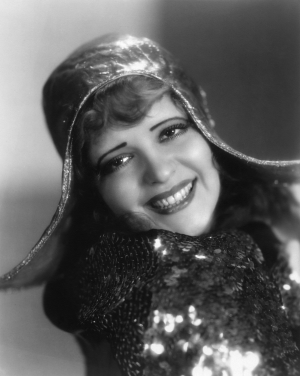
Clara Bow
- TitleClara Bow papers, 1926 - 1965 (inclusive)
- Collector
- Date(s)1926 - 1965 (inclusive)
1926 - 1935 (bulk)
1950 - 1964 (bulk) - Related names
- Description
3.5 linear ft. of papers
1. Production files; 2. Subject files; 3. Oversize
- Summary
The collection includes clippings, reviews, and publicity materials for CALL HER SAVAGE (1932), DANGEROUS CURVES (1929), HOOPLA (1933), IT (1927), MANTRAP (1926), THE PLASTIC AGE (1926), RED HAIR (1928), and WINGS (1927). The subject files consists of clippings, correspondence, and fan mail. Of particular interest is Bow’s fan mail, ranging in years from 1926 to 1965.
- Scope notes
Special Collections
The Clara Bow papers span the years 1926-1965 (bulk 1926-1935 and 1950-1964) and encompass approximately 3.5 linear feet. The collection includes production and subject files. The production files contain clippings, reviews, and publicity materials from some of Bow’s biggest box office and critical successes, including CALL HER SAVAGE (1932), DANGEROUS CURVES (1929), HOOPLA (1933), IT (1927), MANTRAP (1926), THE PLASTIC AGE (1926), RED HAIR (1928), and WINGS (1927). The subject files consist of clippings, correspondence, and fan mail. The clippings, both domestic and foreign, include articles, portraits, and magazine covers with annotations by Bow. There are also clippings regarding the trial of Daisy DeVoe, Bow’s former assistant, and clippings from the "Los Angeles Examiner" of a multi-part biography of Bow written by Louella O. Parsons in 1931. Also included are non-career related clippings that Bow collected during her life. Among the correspondence are cards and letters from Clarence Badger, Harry Richman, Gilbert Roland, Barbara Stanwyck, and Bow’s husband, actor Rex Bell. Of particular interest is Bow’s fan mail, ranging in years from 1926-1965.Photograph Archive
The photograph series of the Clara Bow papers includes production, biography, and subject series. The majority of materials are photographic prints, but there are also 40 postcards across all series. The motion picture production series contains 37 items from a wide range of films, including RED HAIR (1928), DANGEROUS CURVES (1929), and WINGS (1927). The biography series contains 121 items, the bulk of which is Clara Bow and her family, including husband, actor Rex Bell. Other notable people include James Garner and President Dwight D. Eisenhower. The subject series contains 31 photos of residences, pets, and the 1939 World’s Fair. - BiographyClara Bow (1905-1965) was born Clara Gordon Bow in Brooklyn, New York. An American silent film actress, Bow embodied the Roaring Twenties and was personified as “The It Girl.” Bow’s acting career began in January 1921 after she won a movie role in the "Fame and Fortune Contest" sponsored by "Motion Picture Magazine." Even though Bow’s part in the film BEYOND THE RAINBOW (1922) was cut, she continued to pursue an acting career. Bow’s screen debut arrived with her next film, DOWN TO THE SEA IN SHIPS (1923). Although Bow was only a supporting player, many New York film critics singled her out for her exceptional performance. Shortly thereafter, Jack Bachman, a partner with B.P. Schulberg in Preferred Pictures, an independent production and distribution company based in Hollywood, offered Bow train fare to California and a three-month trial at $50 a week. A week before her 18th birthday, Bow departed New York's Grand Central Station for Hollywood. Initially unimpressed by Bow’s looks, B. P. Schulberg reluctantly granted Bow a screen test, but her natural acting ability changed his mind. In 1924 Bow was named a WAMPAS baby star by the Western Association of Motion Picture Advertisers, the highest honor of the day for an aspiring screen actress. Bow worked constantly over the next few years, making more than 20 films before THE PLASTIC AGE (1926) made her a star. In 1926, when Schulberg was appointed head of productions at Paramount Pictures, he brought Bow with him and paired her with top talent and better directors. Her big break came with MANTRAP (1926), directed by Victor Fleming, which opened to rave reviews and big box office. Paramount then signed Bow to a five-year contract. Bow reached the height of her popularity as a shopgirl who seduces her employer in IT (1927), adapted from Elinor Glyn's novella. Bow was consequently dubbed “The It Girl”- “It” being a euphemism for sex appeal. Bow's next film, WINGS (1927), became one of the biggest successes of the silent era, winning the first Academy Award® for Best Picture. Although Bow was one of Paramount’s biggest silent film stars, her fame waned after she appeared in Paramount's first sound film, THE WILD PARTY (1929). At the height of her career, Bow was besieged by fan mail, with thousands of letters arriving each month. The media documented her numerous personal problems including her broken engagements and a damaging public court trial involving her former assistant, Daisy DeVoe. In 1931, Bow took a one-year hiatus from acting and married actor Rex Bell. Bow signed a two-picture deal with Fox Film Corporation in 1932 and returned to the screen with two successful films: CALL HER SAVAGE (1932) and HOOPLA (1933). Bow then retired from the screen at age 28 and devoted the rest of her life to her husband and two sons.
- Subjects
- Acquisitions InformationGift of Rex Bell Jr., 2002
- Preferred citationClara Bow papers, Margaret Herrick Library, Academy of Motion Picture Arts and Sciences.
- DepartmentLibrary
- 511
- AvailabilityFor information on the contents and availability of this collection please contact the Reference and Public Services department at ref@oscars.org.
- Moving Image Items
- Library Holdings
